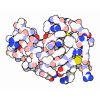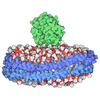+ Open data
Open data
- Basic information
Basic information
| Entry | Database: PDB / ID: 4uis | ||||||
|---|---|---|---|---|---|---|---|
| Title | The cryoEM structure of human gamma-Secretase complex | ||||||
 Components Components |
| ||||||
 Keywords Keywords | HYDROLASE / GAMMA-SECRETASE | ||||||
| Function / homology |  Function and homology information Function and homology informationCajal-Retzius cell differentiation / positive regulation of L-glutamate import across plasma membrane / amyloid precursor protein biosynthetic process / negative regulation of core promoter binding / gamma-secretase complex / short-term synaptic potentiation / aspartic endopeptidase activity, intramembrane cleaving / positive regulation of amyloid precursor protein biosynthetic process / smooth endoplasmic reticulum calcium ion homeostasis / Noncanonical activation of NOTCH3 ...Cajal-Retzius cell differentiation / positive regulation of L-glutamate import across plasma membrane / amyloid precursor protein biosynthetic process / negative regulation of core promoter binding / gamma-secretase complex / short-term synaptic potentiation / aspartic endopeptidase activity, intramembrane cleaving / positive regulation of amyloid precursor protein biosynthetic process / smooth endoplasmic reticulum calcium ion homeostasis / Noncanonical activation of NOTCH3 / protein catabolic process at postsynapse / TGFBR3 PTM regulation / sequestering of calcium ion / Notch receptor processing / synaptic vesicle targeting / positive regulation of coagulation / central nervous system myelination / negative regulation of axonogenesis / membrane protein intracellular domain proteolysis / skin morphogenesis / choline transport / T cell activation involved in immune response / NOTCH4 Activation and Transmission of Signal to the Nucleus / dorsal/ventral neural tube patterning / ciliary rootlet / neural retina development / regulation of resting membrane potential / L-glutamate import across plasma membrane / Regulated proteolysis of p75NTR / regulation of phosphorylation / myeloid dendritic cell differentiation / endoplasmic reticulum calcium ion homeostasis / brain morphogenesis / locomotion / amyloid precursor protein metabolic process / regulation of synaptic vesicle cycle / regulation of long-term synaptic potentiation / regulation of postsynapse organization / astrocyte activation involved in immune response / embryonic limb morphogenesis / cell fate specification / regulation of canonical Wnt signaling pathway / aggresome / myeloid cell homeostasis / growth factor receptor binding / skeletal system morphogenesis / Hydrolases; Acting on peptide bonds (peptidases); Aspartic endopeptidases / azurophil granule membrane / G protein-coupled dopamine receptor signaling pathway / glutamate receptor signaling pathway / positive regulation of amyloid fibril formation / : / blood vessel development / amyloid-beta formation / mitochondrial transport / amyloid precursor protein catabolic process / heart looping / regulation of neuron projection development / positive regulation of dendritic spine development / adult behavior / cerebral cortex cell migration / positive regulation of receptor recycling / smooth endoplasmic reticulum / nuclear outer membrane / membrane protein ectodomain proteolysis / negative regulation of apoptotic signaling pathway / negative regulation of ubiquitin-dependent protein catabolic process / EPH-ephrin mediated repulsion of cells / autophagosome assembly / endopeptidase activator activity / neuron development / somitogenesis / hematopoietic progenitor cell differentiation / T cell proliferation / regulation of synaptic transmission, glutamatergic / viral release from host cell by cytolysis / Nuclear signaling by ERBB4 / calcium ion homeostasis / rough endoplasmic reticulum / Degradation of the extracellular matrix / Notch signaling pathway / peptidoglycan catabolic process / neuron projection maintenance / astrocyte activation / NOTCH2 Activation and Transmission of Signal to the Nucleus / NRIF signals cell death from the nucleus / cellular response to calcium ion / Activated NOTCH1 Transmits Signal to the Nucleus / cerebellum development / thymus development / positive regulation of glycolytic process / dendritic shaft / epithelial cell proliferation / post-embryonic development / PDZ domain binding / NOTCH3 Activation and Transmission of Signal to the Nucleus / neuromuscular junction / apoptotic signaling pathway / cell-cell adhesion / sarcolemma Similarity search - Function | ||||||
| Biological species |  HOMO SAPIENS (human) HOMO SAPIENS (human) | ||||||
| Method | ELECTRON MICROSCOPY / single particle reconstruction / cryo EM / Resolution: 4.4 Å | ||||||
 Authors Authors | Sun, L. / Zhao, L. / Yang, G. / Yan, C. / Zhou, R. / Zhou, X. / Xie, T. / Zhao, Y. / Wu, S. / Li, X. / Shi, Y. | ||||||
 Citation Citation |  Journal: Proc Natl Acad Sci U S A / Year: 2015 Journal: Proc Natl Acad Sci U S A / Year: 2015Title: Structural basis of human γ-secretase assembly. Authors: Linfeng Sun / Lingyun Zhao / Guanghui Yang / Chuangye Yan / Rui Zhou / Xiaoyuan Zhou / Tian Xie / Yanyu Zhao / Shenjie Wu / Xueming Li / Yigong Shi /  Abstract: The four-component intramembrane protease γ-secretase is intricately linked to the development of Alzheimer's disease. Despite recent structural advances, the transmembrane segments (TMs) of γ- ...The four-component intramembrane protease γ-secretase is intricately linked to the development of Alzheimer's disease. Despite recent structural advances, the transmembrane segments (TMs) of γ-secretase remain to be specifically assigned. Here we report a 3D structure of human γ-secretase at 4.32-Å resolution, determined by single-particle, electron cryomicroscopy in the presence of digitonin and with a T4 lysozyme fused to the amino terminus of presenilin 1 (PS1). The overall structure of this human γ-secretase is very similar to that of wild-type γ-secretase determined in the presence of amphipols. The 20 TMs are unambiguously assigned to the four components, revealing principles of subunit assembly. Within the transmembrane region, PS1 is centrally located, with its amino-terminal fragment (NTF) packing against Pen-2 and its carboxyl-terminal fragment (CTF) interacting with Aph-1. The only TM of nicastrin associates with Aph-1 at the thick end of the TM horseshoe, and the extracellular domain of nicastrin directly binds Pen-2 at the thin end. TM6 and TM7 in PS1, which harbor the catalytic aspartate residues, are located on the convex side of the TM horseshoe. This structure serves as an important framework for understanding the function and mechanism of γ-secretase. | ||||||
| History |
|
- Structure visualization
Structure visualization
| Movie |
 Movie viewer Movie viewer |
|---|---|
| Structure viewer | Molecule:  Molmil Molmil Jmol/JSmol Jmol/JSmol |
- Downloads & links
Downloads & links
- Download
Download
| PDBx/mmCIF format |  4uis.cif.gz 4uis.cif.gz | 286.4 KB | Display |  PDBx/mmCIF format PDBx/mmCIF format |
|---|---|---|---|---|
| PDB format |  pdb4uis.ent.gz pdb4uis.ent.gz | 230.5 KB | Display |  PDB format PDB format |
| PDBx/mmJSON format |  4uis.json.gz 4uis.json.gz | Tree view |  PDBx/mmJSON format PDBx/mmJSON format | |
| Others |  Other downloads Other downloads |
-Validation report
| Summary document |  4uis_validation.pdf.gz 4uis_validation.pdf.gz | 897.9 KB | Display |  wwPDB validaton report wwPDB validaton report |
|---|---|---|---|---|
| Full document |  4uis_full_validation.pdf.gz 4uis_full_validation.pdf.gz | 932.5 KB | Display | |
| Data in XML |  4uis_validation.xml.gz 4uis_validation.xml.gz | 35.5 KB | Display | |
| Data in CIF |  4uis_validation.cif.gz 4uis_validation.cif.gz | 55.7 KB | Display | |
| Arichive directory |  https://data.pdbj.org/pub/pdb/validation_reports/ui/4uis https://data.pdbj.org/pub/pdb/validation_reports/ui/4uis ftp://data.pdbj.org/pub/pdb/validation_reports/ui/4uis ftp://data.pdbj.org/pub/pdb/validation_reports/ui/4uis | HTTPS FTP |
-Related structure data
- Links
Links
- Assembly
Assembly
| Deposited unit | 
|
|---|---|
| 1 |
|
- Components
Components
| #1: Protein | Mass: 63331.977 Da / Num. of mol.: 1 Source method: isolated from a genetically manipulated source Source: (gene. exp.)  HOMO SAPIENS (human) / Cell line (production host): HEK 293S / Production host: HOMO SAPIENS (human) / Cell line (production host): HEK 293S / Production host:  HOMO SAPIENS (human) / References: UniProt: Q92542*PLUS HOMO SAPIENS (human) / References: UniProt: Q92542*PLUS |
|---|---|
| #2: Protein | Mass: 23547.639 Da / Num. of mol.: 1 Source method: isolated from a genetically manipulated source Source: (gene. exp.)  HOMO SAPIENS (human) / Cell line (production host): HEK 293S / Production host: HOMO SAPIENS (human) / Cell line (production host): HEK 293S / Production host:  HOMO SAPIENS (human) / References: UniProt: P49768*PLUS HOMO SAPIENS (human) / References: UniProt: P49768*PLUS |
| #3: Protein | Mass: 16698.539 Da / Num. of mol.: 1 Source method: isolated from a genetically manipulated source Source: (gene. exp.)  HOMO SAPIENS (human) / Cell line (production host): HEK 293S / Production host: HOMO SAPIENS (human) / Cell line (production host): HEK 293S / Production host:  HOMO SAPIENS (human) HOMO SAPIENS (human) |
| #4: Protein | Mass: 5294.518 Da / Num. of mol.: 1 Source method: isolated from a genetically manipulated source Source: (gene. exp.)  HOMO SAPIENS (human) / Cell line (production host): HEK 293S / Production host: HOMO SAPIENS (human) / Cell line (production host): HEK 293S / Production host:  HOMO SAPIENS (human) HOMO SAPIENS (human) |
| #5: Protein | Mass: 18435.207 Da / Num. of mol.: 1 Source method: isolated from a genetically manipulated source Source: (gene. exp.)  HOMO SAPIENS (human) / Cell line (production host): HEK 293S / Production host: HOMO SAPIENS (human) / Cell line (production host): HEK 293S / Production host:  HOMO SAPIENS (human) HOMO SAPIENS (human)References: UniProt: A0A097J809, UniProt: D9IEF7*PLUS, lysozyme |
| Has protein modification | Y |
-Experimental details
-Experiment
| Experiment | Method: ELECTRON MICROSCOPY |
|---|---|
| EM experiment | Aggregation state: PARTICLE / 3D reconstruction method: single particle reconstruction |
- Sample preparation
Sample preparation
| Component | Name: T4-LYSOZYME FUSION GAMMA- SECRETASE / Type: COMPLEX |
|---|---|
| Buffer solution | Name: 0.1% DIGITONIN, 25 MM HEPES, PH 7.4, AND 150 MM NACL. / pH: 7.4 Details: 0.1% DIGITONIN, 25 MM HEPES, PH 7.4, AND 150 MM NACL. |
| Specimen | Conc.: 4.2 mg/ml / Embedding applied: NO / Shadowing applied: NO / Staining applied: NO / Vitrification applied: YES |
| Specimen support | Details: HOLEY CARBON |
| Vitrification | Instrument: FEI VITROBOT MARK IV / Cryogen name: ETHANE Details: VITRIFICATION 1 -- CRYOGEN- ETHANE, HUMIDITY- 100, TEMPERATURE- 277, INSTRUMENT- FEI VITROBOT MARK IV, METHOD- BLOT FOR 3 SECONDS BEFORE PLUNGING, |
- Electron microscopy imaging
Electron microscopy imaging
| Experimental equipment |  Model: Titan Krios / Image courtesy: FEI Company |
|---|---|
| Microscopy | Model: FEI TITAN KRIOS / Date: Dec 22, 2014 |
| Electron gun | Electron source:  FIELD EMISSION GUN / Accelerating voltage: 300 kV / Illumination mode: SPOT SCAN FIELD EMISSION GUN / Accelerating voltage: 300 kV / Illumination mode: SPOT SCAN |
| Electron lens | Mode: BRIGHT FIELD / Nominal defocus max: 3000 nm / Nominal defocus min: 1500 nm / Cs: 1.4 mm |
| Image recording | Electron dose: 4.5 e/Å2 / Film or detector model: DIRECT ELECTRON DE-12 (4k x 3k) |
| Image scans | Num. digital images: 2000 |
- Processing
Processing
| EM software |
| ||||||||||||
|---|---|---|---|---|---|---|---|---|---|---|---|---|---|
| Symmetry | Point symmetry: C1 (asymmetric) | ||||||||||||
| 3D reconstruction | Resolution: 4.4 Å / Num. of particles: 177207 / Nominal pixel size: 1.32 Å / Actual pixel size: 1.32 Å Details: SUBMISSION BASED ON EXPERIMENTAL DATA FROM EMDB EMD-2974. (DEPOSITION ID: 13293 Symmetry type: POINT | ||||||||||||
| Atomic model building | Protocol: FLEXIBLE FIT / Space: REAL / Details: METHOD--FLEXIBLE | ||||||||||||
| Atomic model building | PDB-ID: 4R12 Accession code: 4R12 / Source name: PDB / Type: experimental model | ||||||||||||
| Refinement | Highest resolution: 4.4 Å | ||||||||||||
| Refinement step | Cycle: LAST / Highest resolution: 4.4 Å
|
 Movie
Movie Controller
Controller






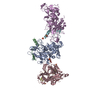


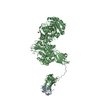


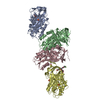
 PDBj
PDBj